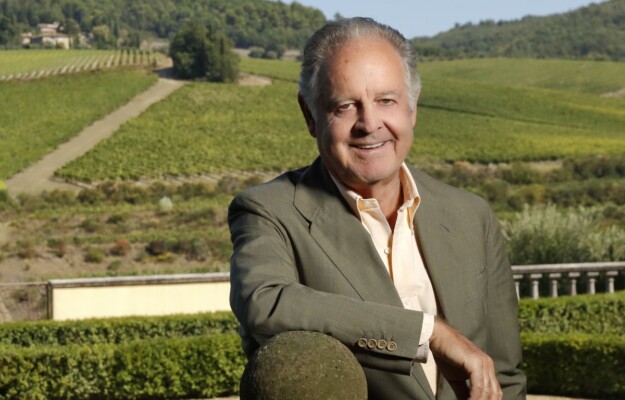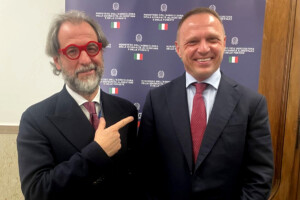New and old uncertainties affect the wine world, which has gone through a 2024 of ups and downs, with a global slowdown in consumption and now faces inflation, wars, healthism, changing consumption, and climate change. But “in my career, I have experienced many phases of crisis in the wine world. All of them have been overcome. This one will be too. There are many elements of concern and difficulty for the sector, but Italian wine has grown so much in quality, and there are so many markets in the world yet to be discovered and conquered. We must have confidence in the values of this product and believe in the future”. This is the thought, to WineNews, of Piero Antinori, the noble father of the Italian wine renaissance, for decades at the helm of Marchesi Antinori, Italy's leading wine reality, now led by his daughters Albiera, Allegra and Alessia, with CEO Renzo Cotarella. A message picked up, in recent days, in “I Colloqui dell’Economia” at the Florence Chamber of Commerce, where Piero Antinori retraced his personal history, which coincides with that of the Tuscan and Italian wine market, and described his vision around “hot” topics.
On stage, Piero Antinori put together his memories of the agricultural and commercial development of the Tuscan countryside: “In the last fifty years, wine has made more progress than in previous millennia. Florence and Tuscany, the cradle of the artistic and scientific Renaissance, have also been the protagonists of a wine renaissance. The city was once the financial heart of Europe: Florentine bankers lent money to rulers and the Vatican. The florin was like today’s dollar. This legacy of culture, art and innovation is also reflected in wine production”. Antinori pointed out how, only 60 years ago, Tuscan wine (but that applies to all Italian wine) was going through a period of serious crisis: “not only did we manage to avoid decline, but we transformed production in crisis into one of the world’s excellences. From a model based on quantity and low cost, we moved to one based on quality and sustainability”. This change has affected not only wine, but also the Tuscan landscape: “viticulture has saved the countryside from abandonment, preserving the beauty of the hills, which today represent an extraordinary added value”.
Tuscany, thanks to a unique variety of productions, ranging from Chianti Classico to Brunello di Montalcino, from Vernaccia di San Gimignano to the wines of Bolgheri and the Maremma, is today a world reference point: “our strong point is the combination of history, culture, beauty and gastronomy, which makes us competitive on international markets”, added Piero Antinori. That regarding the downturn in wine consumption that has been experienced, a bit everywhere, in recent months, he is optimistic: “it is a momentary trend. Consumers’ tastes are evolving, and they will be increasingly oriented toward wines characterized by elegance and finesse, characteristics that Tuscany can offer. Wine cannot be compared to spirits: if consumed intelligently, it can also have beneficial effects on health”.
Among the topics discussed, looking to the future, was the risk of the duties announced by Trump, in the U.S., the first market for Italian and Tuscan wine: “everything that hinders free trade is negative. However”, added Piero Antinori, “the strengthening of the dollar could offset these obstacles: the United States has become the world’s leading wine consumer, and despite a slight lull, it is a key market”. Among the market’s great promises, which have been missed so far, is China. Which Antinori described as a potentially huge but still secondary market: “The French were more successful initially, but, as in the United States, Italian wines are gaining ground in China. When this market is mature, Italian wine will have its well-deserved place”.
Looking back, Piero Antinori mentioned his beginnings, “In the United States, Italian wine was considered little more than a joke. People sold flasks because they were useful as candlesticks. Today, thanks to a long path of quality and promotion, Italian wine is a pillar of Made in Italy. We have made great strides, but one of our limitations is individualism. Fortunately, in recent times, consortia and collaborations between producers have been created, combining the specificity of our traditions with the strength of teamwork”. Among the issues on the plate in the wine world, in any case, is that of rebalancing between production, now in excess, and demand, which is declining. And if thousands of hectares of vineyards are being explanted in France, as has also happened in Australia, for example, today they are beginning to discuss it in Italy and Spain as well. But for those, like Piero Antinori, who have always invested first and foremost in the land, it is not the right path, as he explained again to WineNews: “I believe, that to uproot the vineyard, especially in vocated areas, is an impoverishment of the territory, also from the social point of view. I believe that this should be avoided in every way. The right way is, if anything, to spend the money on communication, on the promotion of our products, including, as I said, in markets that, until now, have not been important markets for wine consumption, but that, certainly, will and can be”.
With an optimistic outlook on the future, Piero Antinori believes, therefore, that wine, of Tuscany and Italy, will continue to grow and conquer global markets, remaining a symbol of excellence and culture. With a wish for 2025, now just around the corner: “we must continue, with passion and confidence, to believe in our product. I believe in it, and the wish is for everyone to have faith in the future”.
Copyright © 2000/2025
Contatti: info@winenews.it
Seguici anche su Twitter: @WineNewsIt
Seguici anche su Facebook: @winenewsit
Questo articolo è tratto dall'archivio di WineNews - Tutti i diritti riservati - Copyright © 2000/2025









































































































































































































